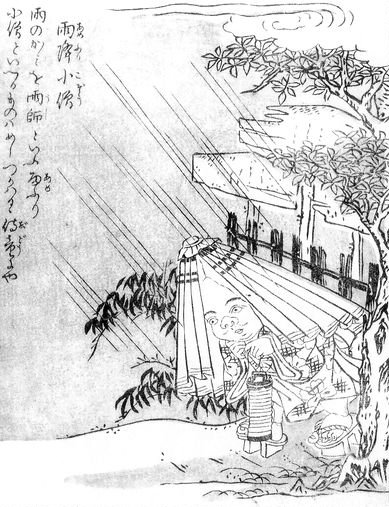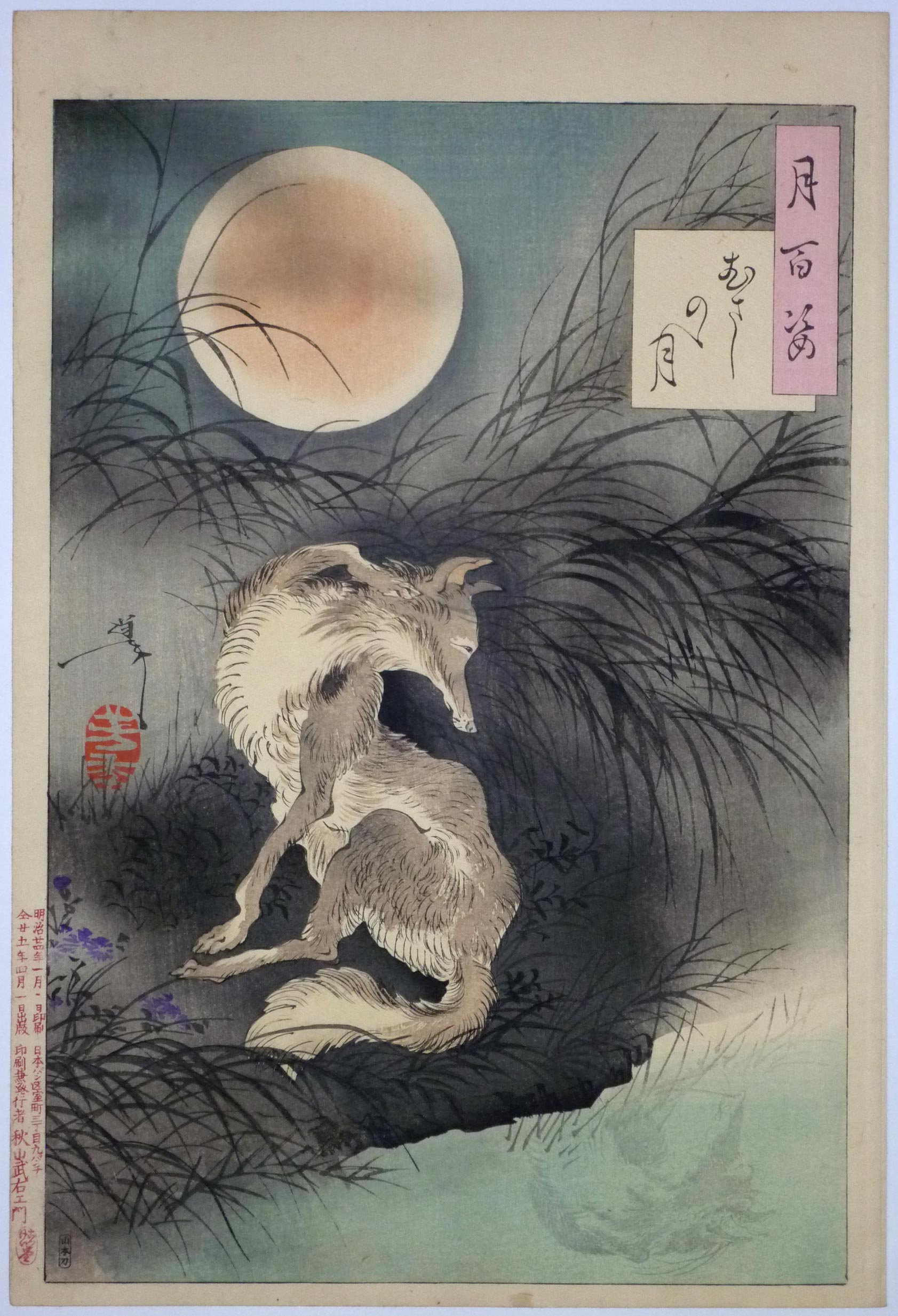|
Amefurikozō
is a type of Japanese ''yōkai''. There is a depiction of this ''yōkai'' in Sekien Toriyama's collection of ''yōkai'' drawing the ''Konjaku Gazu Zoku Hyakki'', and they can also be seen in the ''kibyōshi'' among other publications of the same era. Classics In the ''Konjaku Gazu Zoku Hyakki'' it wears a Japanese umbrella with its central pole missing, and it is depicted possessing a paper lantern. In the explanatory text, it says, "", stating that they are the jidō (children employed by the nobility) of the Chinese god of rain "Ushi". Since is an honorary title of the nobility (大人, "ushi"), and since can be understood as meaning "children", there is the interpretation that it is a yōkai depicted using a play on words "a child employed by an adult". In the kibyōshi of the Edo period, just like the popular kibyōshi character tōfu-kozō, they appear as yōkai that take on the role of servants. In the kibyōshi "" by Jihinari Sakuragawa and illustrated by Utagawa Toy ... [...More Info...] [...Related Items...] OR: [Wikipedia] [Google] [Baidu] |
List Of Legendary Creatures From Japan
The following is a list of Akuma (demons), Yūrei (ghosts), Yōkai (spirits), Kami and other legendary creatures that are notable in Japanese folklore and mythology. A B C D E F G H I J K A Kesaran Pasaran ... [...More Info...] [...Related Items...] OR: [Wikipedia] [Google] [Baidu] |
Konjaku Gazu Zoku Hyakki
is the second book of Japanese artist Toriyama Sekien's famous ''Gazu Hyakki Yagyō'' tetralogy, published c. 1779. A version of the tetralogy translated and annotated in English was published in 2016. These books are supernatural Bestiary, bestiaries, collections of ghosts, spirits, spooks, and monsters, many of which Toriyama based on Japanese literature, literature, Japanese folklore, folklore, other Japanese art, artwork. These works have had a profound influence on subsequent ''yōkai'' imagery in Japan. ''Konjaku Gazu Zoku Hyakki'' is preceded in the series by ''Gazu Hyakki Yagyō'', and succeeded by ''Konjaku Hyakki Shūi'' and ''Gazu Hyakki Tsurezure Bukuro''. List of creatures The three volumes were titled 雨, 晦, and 明. From this book, Toriyama added captions. First Volume – 雨 (Rain) Image:SekienOmagatoki.jpg, Image:SekienOni.jpg, Image:SekienSansei.jpg, Image:SekienHiderigami.jpg, Image:SekienSuiko.jpg, Image:SekienSatori.jpg, Image:SekienShuten-doj ... [...More Info...] [...Related Items...] OR: [Wikipedia] [Google] [Baidu] |
Mizuki Shigeru Road
Mizuki is both a Japanese surname (水木, みずき, ミズキ) and a Japanese given name which means "auspicious hope". Notable people with the name include: Surname *Alisa Mizuki, a J-pop singer and actress *Hakase Mizuki, Japanese manga artist *Ichirou Mizuki, an actor, voice actor and singer *Joh Mizuki, Japanese actor *Kaoru Mizuki, Japanese actress *Nana Mizuki, a Japanese voice actress and singer *Shigeru Mizuki, a Japanese manga artist and author of ''Ge Ge Ge no Kitaro'' Given name *Mizuki, a Japanese singer and member of Shiritsu Ebisu Chugaku *, Japanese footballer *, Japanese badminton player *Mizuki Fukumura, (譜久村 聖, born 1996) Japanese pop singer, former Morning Musume member * Mizuki Hamada, (賓田 水輝, born 1990) American-born Japanese football defender *, Japanese footballer *Mizuki Inoue, (井上 水樹, born 1994) Japanese female kickboxer and mixed martial artist * Mizuki Kaminade, (上撫 瑞希, born 1995) Japanese professional wrestler * Mizuki Ka ... [...More Info...] [...Related Items...] OR: [Wikipedia] [Google] [Baidu] |
Kitsune No Yomeiri
The is a term or metaphor for certain natural phenomena, or a folk belief regarding a supernatural event, in Honshu, Shikoku, and Kyushu. The term "kitsune no yomeiri" can refer to several things: atmospheric ghost lights, in which it appears as if paper lanterns from a wedding procession are floating through the dark; sunshowers; or various other phenomena that may resemble wedding processions and are referenced in classical Japanese Kaidan (parapsychology), ''kaidan'', essays, and legends. The ''kitsune no yomeiri'' is always closely related to foxes, or ''kitsune,'' who often play tricks on humans in Japanese legend; various Shinto rituals and festive rites relating to the ''kitsune no yomeiri'' have been developed in various parts of Japan. As atmospheric ghost lights A topography book of the Echigo Province (now Niigata Prefecture), from the Hōreki period, the "Echigo Nayose" (越後名寄), includes the following statement about the appearance of the "kitsune no yomeiri": ... [...More Info...] [...Related Items...] OR: [Wikipedia] [Google] [Baidu] |
Kitsune
The , in popular Japanese tradition, are foxes or fox spirits that possess supernatural abilities such as shapeshifting, and capable of bewitching people. General overview , though literally a 'fox', becomes in folklore a ' fox spirit', or perhaps a type of . They are ascribed with intelligence and magical or supernatural powers, especially so with long-living foxes. The ''kitsune'' exhibit the ability of , or transforming its shape and appearance, like the '' tanuki'' as well as the ability to , i.e. beguile or bewitch; these terms are related to the generic term meaning "spectre" or "goblin". Another scholar ascribes the ''kitsune'' with being a "disorienting deity" (that makes the traveler lose his way) and such capabilities were also ascribed to badgers (actually '' tanuki'' or raccoon dog) and occasionally to cats (cf. '' bakeneko''). The archetypal method by which the ''kitsune'' tricks () humans is to lead them astray, or make them lose their way. The experiences ... [...More Info...] [...Related Items...] OR: [Wikipedia] [Google] [Baidu] |
Iwate Prefecture
is a Prefectures of Japan, prefecture of Japan located in the Tōhoku region of Honshu. It is the second-largest Japanese prefecture (behind Hokkaido) at , with a population of 1,165,886 (as of July 1, 2023). Iwate Prefecture borders Aomori Prefecture to the north, Akita Prefecture to the west, and Miyagi Prefecture to the south. Morioka is the capital and largest city of Iwate Prefecture; other major cities include Ichinoseki, Iwate, Ichinoseki, Ōshū, Iwate, Ōshū, and Hanamaki, Iwate, Hanamaki. Located on Japan's Pacific Ocean coast, Iwate Prefecture features the easternmost point of Honshu at Cape Todo, and shares the highest peaks of the Ōu Mountains—the longest mountain range in Japan—at the border with Akita Prefecture. Iwate Prefecture is home to famous attractions such as Morioka Castle, the Buddhist temples of Hiraizumi, Iwate, Hiraizumi including Chūson-ji and Mōtsū-ji, the Fujiwara no Sato movie lot and theme park in Ōshū, and the Tenshochi park in Kitaka ... [...More Info...] [...Related Items...] OR: [Wikipedia] [Google] [Baidu] |
Kamihei District, Iwate
is a rural district in Iwate Prefecture, Japan. From 2005, the district consists only of the town of Ōtsuchi, which as of June 1, 2019 had an estimated population of 11,106 with a density of 55.4 per km2 and an area of 200.42 km2. The entire city of Tōno, and all of the city of Kamaishi with the exception of the village of Tōni were formerly part of Kamihei District. Towns and villages The district consists of one town: *Ōtsuchi History Under Mutsu Province Hei District was one of the Edo period districts of Mutsu Province under the Tokugawa shogunate and was completely under the control of Nanbu clan of Morioka Domain. Following the Meiji restoration The , referred to at the time as the , and also known as the Meiji Renovation, Revolution, Regeneration, Reform, or Renewal, was a political event that restored Imperial House of Japan, imperial rule to Japan in 1868 under Emperor Meiji. Althoug ..., on January 4, 1879 Hei District came under Rikuchū Province and ... [...More Info...] [...Related Items...] OR: [Wikipedia] [Google] [Baidu] |
Norio Yamada
Norio (written: , , , , , , , , , , , , , , , , , , , , , , or in hiragana) is a masculine Japanese given name. Notable people with the name include: *, Japanese rower * Norio Hayakawa (born 1944), American activist *, Japanese speed skater *, Japanese professional wrestler *, Japanese cyclist *, Japanese actor *, Japanese journalist *, Japanese ice hockey player *, Japanese astronomer *, Japanese photographer *, Japanese Go player *, Japanese jazz composer and pianist * Norio Matsubara (born 1968), Brazilian racing driver *, Japanese golfer *, Japanese politician *, Japanese footballer *, Japanese spree killer and writer *, Japanese writer *, Japanese physician and geneticist * Norio Nishiyama, Japanese mixed martial artist *, Japanese chief executive *, Japanese footballer * , Japanese female manga artist and illustrator *, Japanese footballer and manager *, Japanese basketball coach *, Japanese sumo wrestler *, Japanese golfer *, Japanese animator, illustrator and character des ... [...More Info...] [...Related Items...] OR: [Wikipedia] [Google] [Baidu] |
Tottori Prefecture
is a Prefectures of Japan, prefecture of Japan located in the Chūgoku region of Honshu. Tottori Prefecture is the List of Japanese prefectures by population, least populous prefecture of Japan at 538,525 (2023) and has a geographic area of . Tottori Prefecture borders Shimane Prefecture to the west, Hiroshima Prefecture to the southwest, Okayama Prefecture to the south, and Hyōgo Prefecture to the east. Tottori, Tottori, Tottori is the capital and largest city of Tottori Prefecture, with other major cities including Yonago, Kurayoshi, and Sakaiminato. Tottori Prefecture is home to the Tottori Sand Dunes, the largest sand dunes system in Japan, and Mount Daisen, the highest peak in the Chūgoku Mountains. Etymology The word "Tottori" in Japanese is formed from two ''kanji'' characters. The first, , means "bird" and the second, means "to get". Early residents in the area made their living catching the region's plentiful waterfowl. The name first appears in the in the 23rd y ... [...More Info...] [...Related Items...] OR: [Wikipedia] [Google] [Baidu] |
Sakaiminato, Tottori
is a city in Tottori Prefecture, Japan. , the city had an estimated population of 32,012 in 13178 households and a population density of 1110 persons per km². The total area of the city is . Geography Sakaiminato is located in far western Tottori Prefecture, at the northern end of the Yumigahama Peninsula. It is surrounded on three sides by Lake Nakaumi, the Sea of Japan, and the Sakai Channel, which connects them. Across the Sakai Channel or across the Eshima Ohashi Bridge, it borders the city of Matsue in Shimane Prefecture. Sakaiminato is located on a sandbar, and the land is very flat, with an average elevation of two meters above sea level. Surrounding municipalities Tottori Prefecture * Yonago Shimane Prefecture * Matsue Climate Sakaiminato has a Humid climate (Köppen ''Cfa'') characterized by warm, wet summers and cold winters with heavy snowfall. The average annual temperature in Sakaiminato is . The average annual rainfall is with July as the wettest month. The ... [...More Info...] [...Related Items...] OR: [Wikipedia] [Google] [Baidu] |
Heisei
The was the period of Japanese history corresponding to the reign of Emperor Akihito from 8 January 1989 until his abdication on 30 April 2019. The Heisei era started on 8 January 1989, the day after the death of the Emperor Hirohito, when his son, Akihito, acceded to the throne as the 125th Emperor. In accordance with Japanese customs, Hirohito was posthumously renamed "Emperor Shōwa" on 31 January 1989. Thus, 1989 corresponds to Shōwa 64 up until 7 January and from 8 January. The Heisei era ended on 30 April 2019 (Heisei 31), with the abdication of Akihito from the Chrysanthemum Throne. It was succeeded by the Reiwa era as then-crown prince Naruhito ascended the throne on 1 May midnight local time. History and meaning Shortly after the death of Emperor Hirohito on 7 January 1989, Keizō Obuchi, then- Chief Cabinet Secretary and later Prime Minister of Japan, hosted a press conference to announce the new era name "Heisei" for Emperor Akihito, and explained its m ... [...More Info...] [...Related Items...] OR: [Wikipedia] [Google] [Baidu] |






